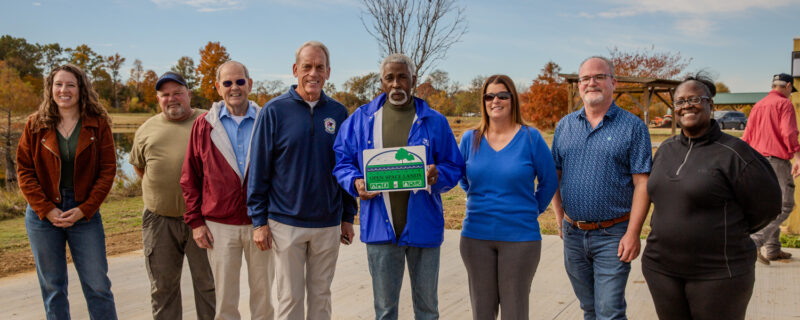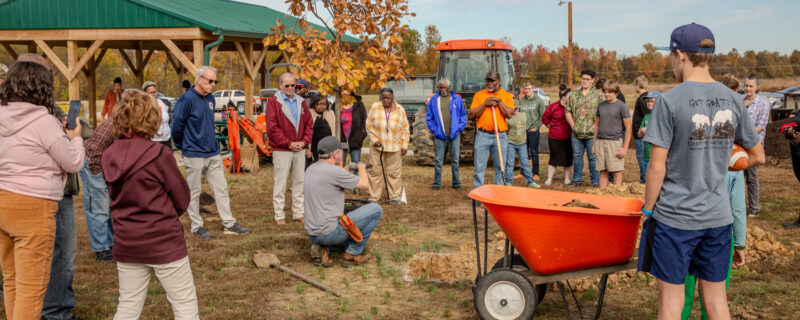FOR IMMEDIATE RELEASE
Contact:
Patricia Wilson | Breaking the Cycle | patricia.wilson@brkcycle.org
Amanda Pankau | Prairie Rivers Network | (217) 840-3057 | apankau@prairierivers.org
Olmsted, Ill. – On Saturday, November 8th, the Village of Olmsted, partners, and community members joined together to celebrate the Grand Opening of the new RV Park and to plant trees at the new site. The campground, built on a reclaimed former clay mine, features five RV spots and a pavilion that offers a shaded space for picnics and gatherings. Twenty native tree species were planted on the site to provide shade, wildlife habitat, and aesthetic value.
“Today’s event is a culmination of years of effort to get the clay mine cleaned up, a campground funded and built, and trees planted,” said Olmsted Mayor Curtis Marshall. “We are excited to have this site open for use both by local community members but also visitors that come to Southern Illinois for all the recreational opportunities our region has to offer.”

The new campground construction and the effort to plant trees on the site represents a community-driven project that involved many community partners, including the Village of Olmsted, the Southern Five Regional Planning District (Southern Five), the local nonprofit Breaking the Cycle, the local University of Illinois Extension 4-H, the statewide nonprofits Faith in Place and Prairie Rivers Network (PRN), and the national nonprofit National Wildlife Federation (NWF).
“Our strength lies in partnerships,” said Patricia Wilson, co-founder of Breaking the Cycle. “Whether it’s securing funding, coordinating volunteers, or planting trees, we’ve all worked together to bring new life to a space that provides opportunities for camping and gathering for years to come.”
The project will continue to involve local youth through the University of Illinois’ Extension 4-H program. Local 4-H Youth Development Educator Kristi Stout shared, “Today’s tree planting symbolizes more than growth in our new RV park — it represents the lasting impact youth can make when they connect with their community and the environment. Our 4-H members are helping plant not just trees, but roots for a stronger, greener future. Working with and for the community builds youth who are ready for work and ready for life.”
The campground was constructed on a former clay mine area that had been recently cleaned up. Southern Five helped the Village of Olmsted secure a grant from the state of Illinois to build the campground, through the Illinois Department of Natural Resources’ Open Space Land Acquisition and Development (OSLAD) program.
Southern Five Executive Director Tiffany George shared, “We’re thrilled that our agency could help secure a $600,000 IDNR grant to support the Village’s vision for a new campground on the reclaimed lake site. This project is a great example of turning our region’s natural and historic resources into new opportunities for recreation, tourism, and economic growth. We’re proud to play a part in helping the community create a destination that will benefit residents and visitors for years to come.”
The tree planting effort, led by Breaking the Cycle, also received funding support from Faith in Place, through a federal USDA grant. While the original ~$30,000 award was reduced to $6,900 due to federal funding rollbacks in 2025, Prairie Rivers Network and the National Wildlife Federation stepped in to help fill the gap.

“With support from our partner National Wildlife Federation, we were proud to contribute $10,000 in support of the Olmsted tree planting project and Breaking the Cycle,” said Amanda Pankau, Director of Energy and Community Resiliency at Prairie Rivers Network. “Working with partners, restoring land and wildlife habitat, protecting watersheds like the Ohio River Basin, and reconnecting people with nature is at the core of our mission, and this project checks every one of those boxes.”
The project also brings to light an unique part of Olmsted’s history: the area’s relationship with the locally abundant and absorbent Porters Creek Clay. The clay has long been extracted with surface mining activities from mines in and around Olmsted, and used to make products like cat litter and oil dry. Some of the clay mines in the area have been reclaimed (i.e. cleaned up), including the location of the tree planting project. At least one mine site, northwest of town, is still operational. A clay processing and manufacturing facility located in Olmsted was long used for processing the clay into products. The facility is closed but was operational for decades, dating back to at least the 1950s. A similar facility is still operational in nearby Mounds.
The Olmstead Historical Society opened their doors on Saturday for folks that were participating in the day’s events. They recently painted their Depot and Caboose, and folks were offered a chance to learn more about the unique history of clay mining, their facilities, and the Olmsted area.
“Mining shaped the landscape and economy of Olmsted for decades,” said Marshall. “The plant was a major employer, I even worked there myself for a time. It’s incredible to now see this land restored and repurposed in a way that benefits the whole community.”







